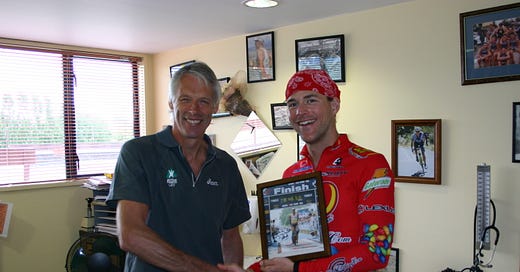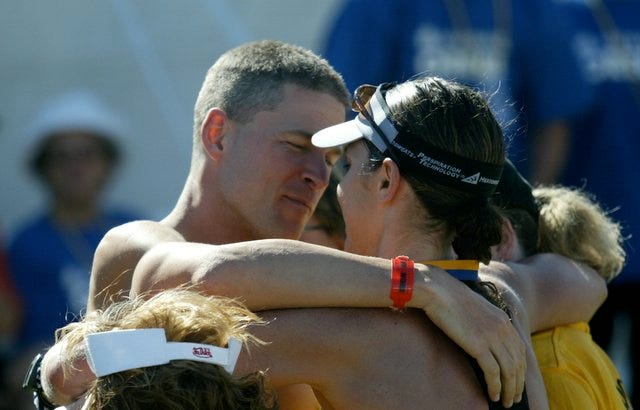When I arrived in New Zealand, John Hellemans
Welcomed me
Taught me
Listened to me
Took care of me
…and he showed me, by example, how one person can have a tremendous impact on their community and the wider world.
Thinking back, I don’t think he charged me anything.
My interview with John shares his training philosophy. What I want to cover in this section is touch on several life lessons he taught me.
In 2000, John welcomed me into his squad. I told him I aspired to be an elite athlete, so he dropped me straight in.
My first swim workout I was in a lane with:
Bevan Docherty - Silver (2004) & Bronze (2008)
I can’t remember if Kris Gemmell (World Aquation Champion, 2002) was there. If not, I met him soon after.
The guys were fast.
I was not fast.
In fact, I was getting lapped every 150m in a 50m pool…
…and they had bands around their ankles.
Not one of them said a thing.
They even took an interest in me and answered my (endless) questions.
Eventually, I got better.
The Wall of Fame

John had a wall-of-fame at his medical practice. Each time I went to the pool, I’d walk past the wall. What would it be like to be that fast?
It took me four years to make the wall. The picture I gave John is my first Ironman Podium. John respected the work that went into my accomplishment.
Whatever your field, you need a wall.
John’s on my wall. I had to beg the guy for a photo.
He thought it might be showing off to hand out pictures of himself.
Elites Can Recover While Training
I had three things going for me when I arrived in Christchurch, NZ.
I could do a lot
I was strong
I loved to train
I was not fast, and my tolerance of intense training was awful (see Molina article).
John shared an observation:
One the key differences, between an amateur and an elite, is the elite can recover while training.
This is a critical insight into YOUR development.
Why can elites recover while moving?
They can recover because they have the capacity to go “easy.”
Before arriving in NZ, I’d spent six years as a hiker, mountaineer and amateur triathlete. Years before I started “training” I’d been developing my capacity.
Roll forward to the COVID-19 Pandemic of 2020. In the pandemic, I dropped my easy training in favor of power & intensity. As a result, I lost one of my key strengths - the ability to recover while moving.
A focus on “bottom-up fitness” will give you my greatest strength as an elite athlete.
The ability to choose, change and sustain pace.
As you build capacity, you unlock the ability to absorb load.
Capacity - Volume - Specific Load - Absorbtion
Compliance & Doing No Harm
John taught me there are always three plans happening:
What the coach lays out
What the athlete does
What the athlete says they do
I extended this into all areas of my life.
What I think I’m doing
What I’m actually doing
What I say I’m doing
Powermeters and wearables shrunk the say-do gap in sport, but it remains.
In the advice you read here, you will find I skew my errors left. I’m doing this because athletes skew effort right.
We share a fear of going too easy. It’s a misplaced fear.
Skew Your Errors Left Because Effort Skews Right
Another, rather Dutch, observation John made one morning…
You like him because he does what you say
John was talking about one of my friends, who you’ll meet later.
He was correct. I like hanging around with kind/compliant people.
The deeper lesson, here.
As a coach, a doctor, or a parent…
When you are in a position of influence…
There is a responsibility not to harm the athlete, patient, or child.
As you’ll read, I failed that test with my friend.
The Pace Always Slows Down
John has a knack for saying the right thing at the right time. He says he has no idea where his tips come from.
I have an idea.
John’s been around sport for his entire life. He’s lived all aspects of it - medicine, competition, coaching, and leadership. John knows how athletes feel because he’s an athlete, himself.
Back in 2008, I invited myself to one of John’s training camps. This time, I wasn’t going to be training with the elites. With eight additional years, Bevan and Kris were far too fast. Instead, John allowed me to attend the Development Camp.
Camp was a blast. Near the end, we had a Standard Distance race in Wanaka. Before the race, John took me aside and said…
Gordo, the pace ALWAYS slows down.
You see, I had a problem. I kept getting dropped on the swim.
We line up on the beach and we’re off.
I find myself in a small group.
And it gets hard.
Then much harder.
To the point where I’m dry heaving into the lake.
And then it slowed down.
And I was there.
At this stage of my career, I was fast enough to have a shot at the win if I came out with the group.
A few words from John had nudged me towards a major breakthrough. Every open water swim thereafter went better for me.
Now, the pace doesn’t always slow down.
In 2005, my wife set the course record for the Ironman New Zealand swim (46 minutes). The pace did not slow that day.
Easy Pace Isn’t Easy
I dug out a favorite video clip of Kris and Bevan for you.
It gives a taste of why I wasn’t up to the 2008 Elite Camp. It also shows where decades of dedication can take you.
When we look at world-class athletes, we think they must be crushing all the time.
What they’re good at is something different.
Showing up, daily, for a long time.
I’d been showing up.
John asked Kris to help me with a lactate test.
We used what became one of my favorite protocols, progressive 1600-meter repeats. I worked my heart rate up from 110 to 170 bpm. Kris noted paces and sampled lactates.
Later, John invited me into his office. With my results, he gave me a suggestion, I was to do my long runs at 4:20 per K pace1.
But Mate, that’s 7 minutes per mile pace
I’d been lumbering (John’s word) around for many years. In fact, I’d lumbered to an Ultraman Hawaii Championship. However, the test indicated that it was time to start doing some running.
My day had come. I’d tapped out the easy gains2.
My friend, Justin Daerr, advises athletes…
Don’t be in a rush to get to the difficult bits.
Smart training is like Justin’s advice.
Showing Up
Holding Back
Stacking Sessions
Building Fitness
What I recommend for you:
Keep Showing Up
Find Experienced Mentors
Build Capacity
Give yourself years to prepare for the “real training.”
Eventually, I’d get my aerobic threshold running pace down to 4 minutes per k. I’ll be using my development to show how you can use an understanding of your lactate profile, and relative breakpoints, to guide training prescription.
How fast was I able to go with my endurance & strength approach? 8:49 for an Ironman with a 3:00 marathon off the bike. 18-months later, I’d take that down to 8:29 with a 2:46 run.
Back To Table of Contents








